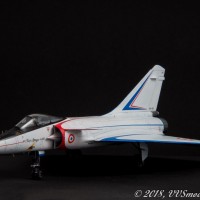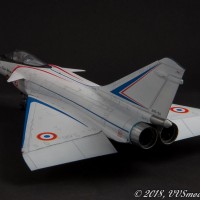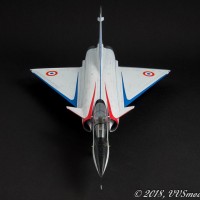Dassault Mirage 4000
Mirage 4000 first flew in March 1979, just a year after it's smaller brother Mirage 2000. And while the latter became a backbone of French Air Force fighter force and a highly successful export product, the 4000 failed to reach any sales – in French service as well as outside. The aircraft was designed to supplement the 2000 as a bigger multi-role fighter similar in a way to F-15E. The aircraft was approximately 30% bigger than Mirage 2000. After it failed to win the Saudi fighter-bomber acquisition (for which it even received temporary desert camouflage), the Dassault, which was privately funding the 4000 project, decided to retire it. Mirage 4000 represents an important step between the Mirage 2000 and Rafale. The sole prototype is now on display at the Paris Air and Space Museum.
The kit
This model is made by Modelsvit exclusively for the French store Bassin Maquette, as were the previous VSTOL versions of Mirage III. The kit ain't cheap by any means, but in terms of details, accuracy and ease of building, it surpasses the resin edition from Anigrand by miles.
As for the kit itself, it is another masterpiece from Modelsvit. The panel lines are even more refined on this kit than they were before and if I am not mistaken, it is the first time, they added rivet details. Being a short run kit, it means that some modelling experience is required as well as some more time for parts preparations. I've only had two areas that proved a bit troublesome – engine exhausts are very thin and the plastic started to crack when I inserted the inner part of the exhausts. The major problem I had was when trying to close the one piece canopy. I've decided to build my Mirage with canopy closed as it looks much better this way. But when I tried to close the one-piece canopy, I simply couldn't. The solution was to cut away the entire avionics bay behind the cockpit as well as a part of turtle back behind the ejection seat. Not a lot of work but a minor setback. The only other critique would be the lack of weapons – you can only add 6 Matra Magic missiles, while the prototype carries quite interesting loadouts during the trials – just look at the above photo. Other than that, the kit is really nicely engineered – PE parts add a nice touch where appropriate, decals perform excellent and the overall fit is very good.
Model Data
Company: Modelsvit
Scale: 1/72
Aftermarket: none
Paints used: Mr.Paint (MRP-004 White, MRP-005 Basic Black, MRP-041 Red, MRP-173 Tire-Rubber Matt)
Alclad (ALC-101 Aluminum, ALC-111 Magnesium, ALC-413 Hotmetal Blue)



















Beautiful presentation, sir...nice all-around job.
Thanks, Craig!
I like this a lot! Love Mirages.
Thanks, Tom. Dassault designs are indeed very eye-pleasing.
Love it. Beautiful, elegant Mirage. great job with this model.
Thank you, Paul!
Very nice indeed.
Thank you, Anthony!
Magnificent job!
Thank you, Bogdan!
Love Mirages, and I don't think I even knew this one existed. Excellent work on it - looks nice and clean like a prototype would. Agree it would be nice to see it armed to the teeth and in war paint!
Thank you, Greg! Yeah it's a unique looking bird. Actually, when they were bidding for Saudi deal (that was won by Tornado), they temporarily painted her in desert camo.
This is a stunning aircraft and its connection to the Mirage 2000 and Rafale is quite evident. Interesting side note to the Mirage 4000 story is the fact that the South African government was looking to get their hands on a fighter that could beat the Mig 23, operated by the Cubans and Angolans, during the "Bush war" that South Africa was fighting at that stage on the border between South West Africa / Namibia and Angola. By 1988 the SAAF had lost air superiority in the skies of southern Angola. The Mirage F 1's were outclassed by the Mig 23's.
In response to this threat Atlas Aviation was to develop a next generation fighter for the SAAF. Dassault had just cancelled the Mirage 4000 so lots of money was made available by the SA government to pay members of the Mirage 4000 design team to help Atlas Aviation develop their fighter. The Israeli Aircraft Industry was also developing a fighter known as the Lavi which was subsequently cancelled and many of their technicians ended up working for Atlas Aviation on Project Carver. The fall of Communism in the USSR ended the Cold War and brought the war in Angola to an end and also contributed to the death of the apartheid system. Between 1990 -1994 South Africa was again accepted into the international community which meant that after 1994 South Africa could again buy weapons on the international market. This caused the termination of project Carver that had moved to the mock-up stage of the airframe. Needless to say Project Carver had many design similarities with the IAI Lavi and the Mirage 4000.
4 attached images. Click to enlarge.
Wow, never heard of project Carver before. Looks like a really neat concept - it's a shame it never materialized. Idea for scratchbuild?
Stunning as usual mate! I really like how the panel lining turned out. Very subtle but perfect for the scale! Two thumbs up!
Thank you, Richard! Panel lines worried me, frankly, but adding some light grey wash helped constraining their looks.
Brilliant work. I know for a fact that white is one of the most difficult shades to paint and you nailed it this time!
MrP saves the day Hvala!
Hvala!